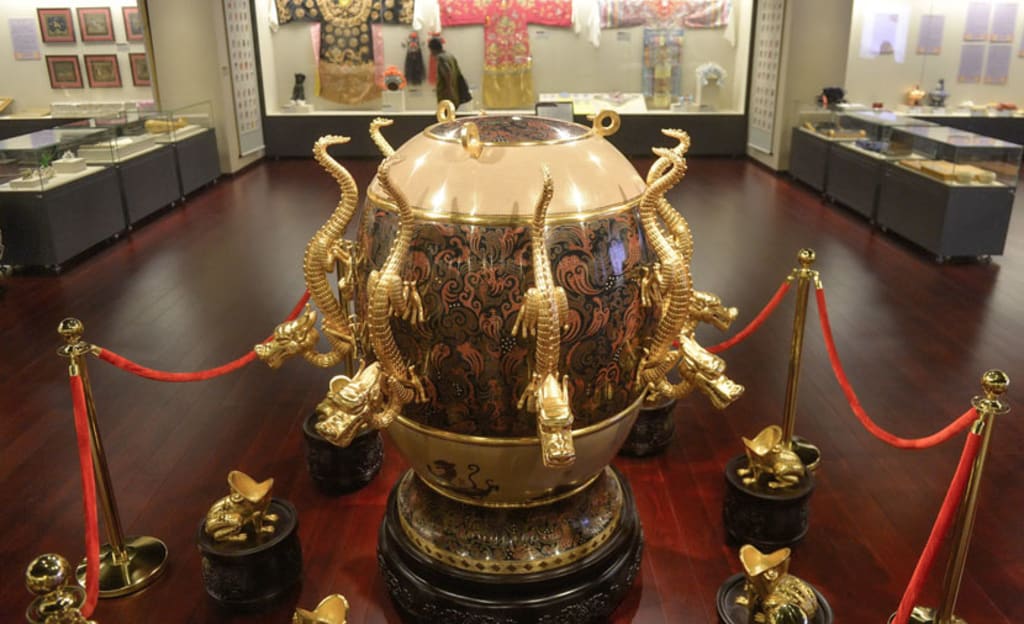
The Chinese seismograph, invented by Zhang Heng during the Eastern Han Dynasty (1st to 2nd century AD), stands as a remarkable testament to the scientific ingenuity of ancient China. This sophisticated device, considered one of the earliest known forms of a seismoscope, represented a monumental leap in early earthquake detection and remains a significant milestone in the history of science and technology.
Imagine the vibrant cities of ancient China, where scholars and artisans worked tirelessly to understand and harness the forces of nature. Among their many innovations, the Chinese seismograph emerged as a pinnacle of their achievements, showcasing a deep-seated curiosity about the natural world and a practical application of scientific principles.
The seismograph designed by Zhang Heng was a marvel of ancient engineering. It consisted of a large bronze vessel adorned with dragon heads at eight equidistant points around its circumference. Inside the vessel, eight bronze dragons each held a ball in their mouths, positioned directly over the mouths of eight bronze toads placed on the ground below. When an earthquake occurred, seismic waves would cause the bronze dragons to drop their balls into the open mouths of the toads, indicating both the occurrence and direction of the tremor.
This ingenious mechanism not only provided a method for detecting earthquakes but also served as an early warning system, alerting officials to seismic activity even from a distance. Such advanced technological foresight demonstrated the ancient Chinese understanding of the interconnectedness between natural phenomena and human affairs, a belief system deeply embedded in their cultural and philosophical worldview.
The significance of Zhang Heng's invention was documented in historical texts such as the "Book of Later Han," where detailed descriptions of the seismograph's construction and operation were recorded. It quickly gained recognition and was celebrated within Chinese society, symbolizing a blend of scientific curiosity, practical utility, and philosophical insight.
Beyond its immediate applications, the Chinese seismograph held profound cultural and scientific implications. It underscored the importance of empirical observation and systematic recording of natural phenomena—a hallmark of ancient Chinese scientific methodology. The device also exemplified the Chinese belief in maintaining harmony with nature, where knowledge of natural occurrences was crucial for maintaining societal stability and balance.
The legacy of the Chinese seismograph extended far beyond its initial invention. The principles underlying Zhang Heng's device influenced later developments in seismology and earthquake engineering, providing a foundational understanding that contributed to the advancement of global earthquake detection and monitoring systems.
Today, while the original bronze seismographs may no longer exist, replicas and models can be found in museums worldwide. These artifacts serve as tangible reminders of ancient Chinese achievements in science and technology, captivating visitors with their ingenuity and historical significance. They continue to inspire awe and curiosity, sparking interest in the study of ancient Chinese civilization and its contributions to human knowledge.
In celebrating the legacy of the Chinese seismograph, we honor not only the intellectual achievements of ancient Chinese scholars and engineers but also reaffirm our commitment to understanding and mitigating the impact of natural disasters. These artifacts remind us of the enduring quest for knowledge and the transformative power of scientific innovation across cultures and centuries.
By studying the Chinese seismograph, we gain insights into the ingenuity and perseverance of our predecessors, encouraging us to continue pushing the boundaries of scientific discovery and technological advancement. The device serves as a beacon of inspiration, motivating future generations to pursue scientific inquiry with the same spirit of curiosity and dedication that drove Zhang Heng and other ancient Chinese pioneers.
Ultimately, the Chinese seismograph stands as a symbol of humanity's timeless pursuit to comprehend and harness the forces of nature—a pursuit that continues to shape our understanding of the world and our efforts to build a safer and more resilient future for all.
About the Creator
Marveline Merab
“History never repeats itself. Man always does.”
― Voltaire
Enjoyed the story? Support the Creator.
Subscribe for free to receive all their stories in your feed. You could also pledge your support or give them a one-off tip, letting them know you appreciate their work.






Comments
There are no comments for this story
Be the first to respond and start the conversation.